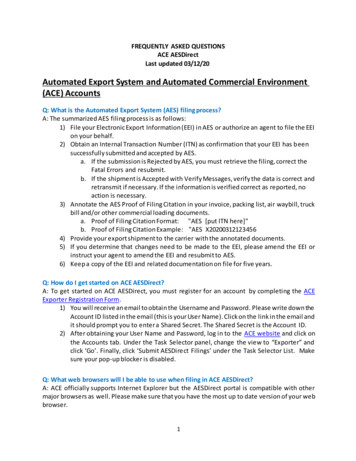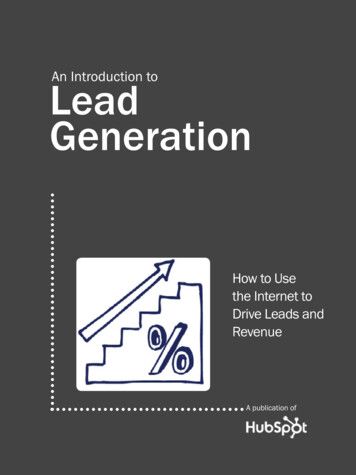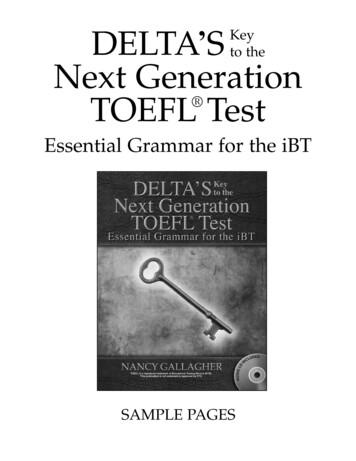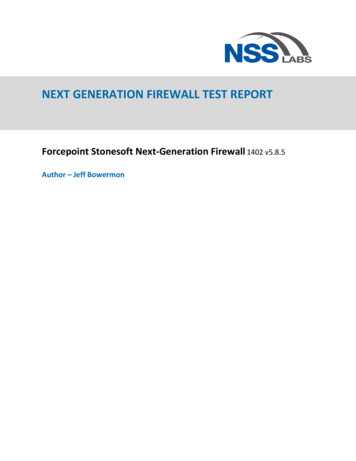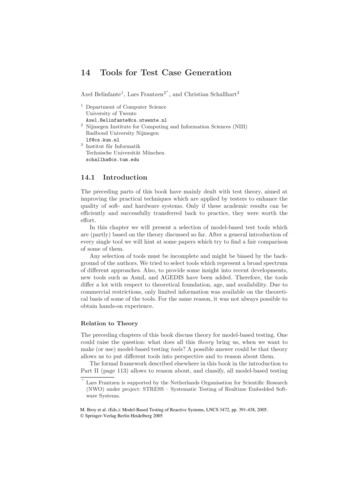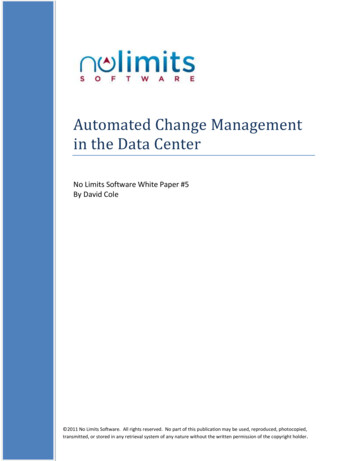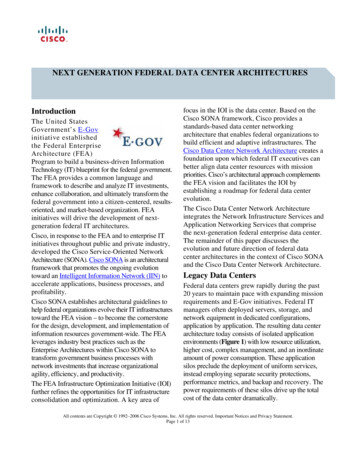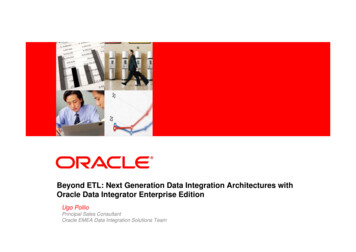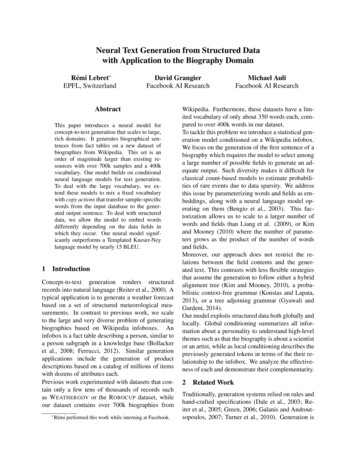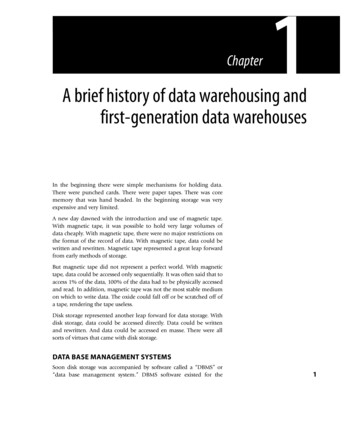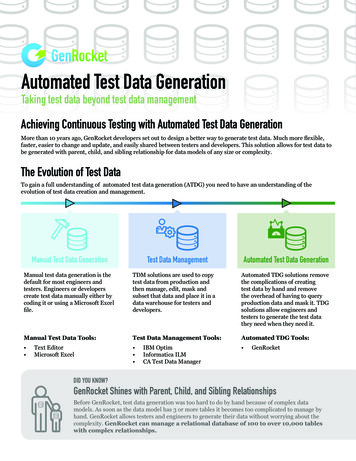
Transcription
Automated Test Data GenerationTaking test data beyond test data managementAchieving Continuous Testing with Automated Test Data GenerationMore than 10 years ago, GenRocket developers set out to design a better way to generate test data. Much more flexible,faster, easier to change and update, and easily shared between testers and developers. This solution allows for test data tobe generated with parent, child, and sibling relationship for data models of any size or complexity.The Evolution of Test DataTo gain a full understanding of automated test data generation (ATDG) you need to have an understanding of theevolution of test data creation and management.Manual Test Data GenerationTest Data ManagementAutomated Test Data GenerationManual test data generation is thedefault for most engineers andtesters. Engineers or developerscreate test data manually either bycoding it or using a Microsoft Excelfile.TDM solutions are used to copytest data from production andthen manage, edit, mask andsubset that data and place it in adata warehouse for testers anddevelopers.Automated TDG solutions removethe complications of creatingtest data by hand and removethe overhead of having to queryproduction data and mask it. TDGsolutions allow engineers andtesters to generate the test datathey need when they need it.Manual Test Data Tools:Test Data Management Tools:Automated TDG Tools: Text EditorMicrosoft ExcelIBM OptimInformatica ILMCA Test Data ManagerGenRocketDID YOU KNOW?GenRocket Shines with Parent, Child, and Sibling RelationshipsBefore GenRocket, test data generation was too hard to do by hand because of complex datamodels. As soon as the data model has 3 or more tables it becomes too complicated to manage byhand. GenRocket allows testers and engineers to generate their data without worrying about thecomplexity. GenRocket can manage a relational database of 100 to over 10,000 tableswith complex relationships.
How Automated Test Data Generation moves beyond TDM’s LimitationsUntil now, TDM solutions have been the only available approach to providing test data sets for complexdatabase environments. Unfortunately due to the complexity and cost of TDM solutions, all requests for testdata had to flow through a central TDM resource. This leads to delays for testers and engineers to get accessto test data for weeks and sometimes months. Automated test data generation (ATDG) is a paradigm shiftfrom TDM -- rather than taking production data, pruning, creating, and storing it, ATDG greatly speeds upthe process by generating model based test data on-demand in real-time.Below are the three key ways that GenRocket’s Automated Test Data Generation solutionpushes past the limitations of TDM.1#HIGHER QUALITY TEST DATAGenRocket provides access to unique, patterned, conditioned,and random test data.GenRocketprovides access tounique, patterned,conditioned, andrandom test data.Unlike TDMsolutions, GenRocketcan create test datafor new data modelsand applications.Automated Test Data GenerationTesters need test data to test -- by just using production data, this prevents testersfrom having access to unique, patterned, conditioned, or random test data whichmeans your application may not be fully tested. By using GenRocket’s ATDG youcan specify what your test data set should look like.TDM solutions do not have easy access to patterned orconditioned test data.With production test data you only have easy access to the type of test data in yourproduction database. Production data allows for basic test cases to be tested but itlacks the necessary variety of test data for some types of test cases.GenRocket can create test data for new data models andapplications.A test data generation solution that can generate test data with complex parentchild relationships is the only solution for unreleased applications. If the test datadoesn’t exist the only way to get access to test data is by generating it.TDM solutions are unable to provide test data for newapplications or new data models.For unreleased applications it is impossible to leverage production test data becauseit doesn’t exist. Today’s distributed applications have significant complexity whichrequire on-demand complex test data for testing.2
2#QUICKLY PROVISION TEST DATA FOR CONTINUOUS TESTINGGenRocket is a decentralized solution which empowers your teamto work more efficiently.GenRocketdecentralizes testdata provisioning.With GenRocket, everyone on the team uses the system and can generate the datathey need when they need it which enables Continuous Integration, ContinuousDelivery, and Continuous Testing.TDM solutions use a centralized model which introducesbottlenecks for test data provisioning.With TDM, testers and engineers often have to wait days or weeks for test data setsto be pruned and delivered to them from a test data manager. This means testersand engineers are not able to do the work they need to do because of this bottleneckwhich severely restricts today’s testing models.GenRocket enables testers to easily modify test data when theyneed to.GenRocket makes iteasy to modify testdata.Testers can quickly iterate on the type and amount of test data they want togenerate. They can easily generate exactly what they need themselves and can nowquickly and thoroughly test core scenarios and also quickly test more edge cases.TDM solutions do not provide a simple way for testers to modifytest data.It’s hard to make iterative test data with production data. If you want to test aspecific scenario you need to have access to the exact test data that matches yourtesting requirements. A tester could try to update the test data manually (many do)but that is slow, complicated, and not scalable.GenRocket is easy to update when your data model changesallowing your team to focus on testing.GenRocket removesthe risk of stale data.ATDG removes the lag-time between the data model changing and test data access.As soon as the data model changes a tester can quickly update the entire team’sdata model in GenRocket. As soon as the data model is updated, Scenarios can beeasily be downloaded and used by the team to generate test data.TDM solutions have to deal with stale test data whenever theapplication’s data model changes.TDM solutions require the storage of pruned test data sets which test datamanagers then distribute to their teams. As time goes on and the data model ofthe application changes that test data becomes stale and needs to be replaced andredistributed. This is a costly and slow process.DID YOU KNOW?GenRocket Supports Mobile TestingSince GenRocket can generate data over Web services it is perfect for generating a high volume ofrealistic test data for mobile applications.
3#LOWER COSTGenRocket Professional is 1,500/license and GenRocketEnterprise is 3,000/license.A GenRocket licenseis 8% the cost of aTDM licenseA GenRocket Professional license can meet all of the test data needs for anyapplication.TDM solutions cost greater than 20,000 for a single seat.This cost doesn’t even include the on-boarding and training fees.GenRocket is designed for anyone on your testing or engineeringteam to use.GenRocket is easy tolearn.The GenRocket system is intuitive and requires only a few days of training. Sinceeveryone on the team is trained on the system there is no knowledge gap left ifsomeone leaves the team since everyone is on the system.A company with a TDM has to hire a specialist to train andmanage the TDM system.If the TDM manager leaves the company there is now a costly knowledge gap to fillsince it takes up to 10 days to get trained on the system plus the cost of the trainingprogram.DID YOU KNOW?GenRocket Supports and Improves Load TestingGenRocket changes the way applications can load test. Our method of load testing provides teams with key insightsthat would have been difficult to obtain before.Before: Unintelligent Load TestingAfter: Intelligent Load Testing Mimic your application’s real world objects Maintain referential integrity of the parent-childrelationships in your data model Control the true conditions of your load tests Ensures that your application’s front-end and back-endbusiness logic, database and hardware are being fullytested under loadUnintelligent load testing is using a high volume oftest data that is not associated to actual user behavior.This strategy prevents teams from:Finding potential bottlenecksVerifying data is stored accuratelyTesting the back-endTesting the business logicTesting the database and hardwareAutomated Test Data GenerationReal-time test data allows your load tests to test thefollowing:4
5 Steps to Implement GenRocketTo implement GenRocket requires some setup steps. Let’s take a look at the five steps to implement this system:1. Import Your Application’s Data Model into GenRocketYou can import your application’s data model into GenRocket using Data Definition Language(DDL) files. You then establish the appropriate parent-child-sibling relationships of yourapplication data model inside GenRocket.2. Assign Generators for Unique DataGenRocket uses a component called Generators to generate the specific data you want.Generators have the ability to talk to each other to generate more complex data includingconditioned test data that follows specific business rules and logic. When you import your datamodel into GenRocket it will automatically assign the correct generator for basic data. For datathat is unique to your application you can customize the data generation.3. Assign Receivers to Format DataGenRocket allows extensible formats of data to be created using a component called Receivers.The Receiver takes the generated data and formats it to your desired format. GenRocket offersover 20 different types of Receivers and more Receivers can be added based on customerrequest.Example Receivers: XML, JSON, SQL, Web services, and JDBC4. Create, Download, and Run ScenariosGenRocket Scenarios are a set of instructions for the GenRocket Runtime on how to generatethe data you want. You create these Scenarios in the GenRocket Web App after you havespecified the data you want to generate with Generators and Receivers. You then downloadthe Scenarios to your local machine. With the GenRocket Runtime you then run each of yourScenarios. The runtime then generates the data on your local machine.5. Use and Update your Test DataAfter your data is created you are free to use for all of your testing needs.Here is where GenRocket shines. When the application’s data model or the testers data needschange it is easy to quickly adjust the test data Scenario’s output in the GenRocket Web App.Enterprise Class Test Data GenerationWe know that enterprise applications are constantly updating and changing. Testers need away to update their test data as fast as the data model changes to ensure Continuous Testing.GenRocket was designed with this specific need in mind. A tester can easily update the datamodel in the GenRocket Web App and quickly download updated test data Scenarios thatreflect the new data model.
GenRocket VersionsSoftwareDescriptionGenRocket ProfessionalGenRocket EnterprisePowerful Test Data GenerationAdvanced Test DataGeneration andAutomated White Box TestingA comprehensive test data solutionfor any testing environment requiringmodel-based synthetic test data tostreamline the testing process.Same as Professional plus advancedtest data generation features andthe ability to automatically generatewhite box test source code to performhigh volume unit testing and complexintegration testing.Data Import: GenRocket can easily import data models from the following file types. DDL FilesCSV FilesSalesforce ObjectsYESYESModeling Data: GenRocket can model the following types of data. RealisticPatternedConditionedRandomNull DataYESYESData Output Format Examples: GenRocket provides over 20 output formats ction Protocols JDBCRESTSalesforceWeb ServicesData Generation Unlimited Data Generation15,000 rows generated persecondAdvanced Test Data Generation Features Project Version Copy: This isfor teams that support multipleversions of their product.Organization Variables: This isfor teams working with multipledatabases that need to maintainreferential integrity across multipleprojects.Automated Test Data Generation6
Supported EnvironmentsGenRocket SystemGenRocket is a combination of a web based and a local component:1. GenRocket Web: A web based application that is accessed via a Chrome, Firefox or Safari Browser. Most customersaccess GenRocket on our secure public servers. GenRocket can be made available for our customers on their own privateservers.2. GenRocket Runtime: A Java runtime that executes GenRocket Scenarios on a local PC or server. The runtime issupported on all major operating systems: Windows, Linux and macOS.Do you support my data format?Each data format is supported through a GenRocket component called a “Receiver”. We plan to offer a Receiver for almostall data formats. Visit the GenRocket web site to see the latest list of Receivers and if you don’t see your data formatsupported today let us know your interest. New Receivers are added at no cost with the understanding that you willbecome a GenRocket customer.About GenRocketGenRocket helps software organizations decrease their business risk by enabling them to fully test their software. Withour help, you can automate the most difficult part of generating test data and build the highest quality products. If youwould like to implement an automated test data generation solution please contact info@genrocket.com and one of ourrepresentatives will reach out to you shortly.Our ServicesGenRocket offers the following solutions to our customers and partners: The world’s only Automated White Box Testing solutionThe world’s most powerful Test Data Generation systemHigh performance testing consulting and related servicesGenRocket, Inc.2930 East Ojai AveOjai, CA 93023USAinfo@genrocket.com1-805-633-8001
Informatica ILM CA Test Data Manager Automated TDG solutions remove the complications of creating test data by hand and remove the overhead of having to query production data and mask it. TDG solutions allow engineers and testers to generate the test data they

